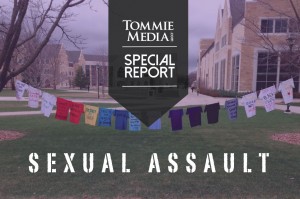
St. Thomas will participate in a nationwide survey intended to gather information about how universities and colleges handle sexual assaults and rapes — part of a growing movement to stop such violence.
Missouri Sen. Claire McCaskill, a former sex crimes prosecutor, launched the survey of 350 schools in late April. St. Thomas received the survey on April 28, according to Dean of Students Karen Lange. She said a small group of administrators will work on it and send it back by mid-May.
In a release, McCaskill said, “This survey gives us an unprecedented look into exactly how our colleges and universities act — or sometimes, fail to act — to protect students, and bring perpetrators to justice.”
The senator’s survey coincides with the April release of guidelines from a White House task force. The guidelines include suggestions on drafting sexual assault policies, information on maintaining confidentiality, and advice on preventing assaults.
St. Thomas President Julie Sullivan said she welcomes the government’s increased focus on sexual assault.
“In order to prevent sexual violence, we need to talk about it and recognize it so that survivors do not feel alone or afraid to come forward,” Sullivan said. “The university will participate in U.S. Sen. Claire McCaskill’s survey and is carefully reviewing the report from the White House Task Force to Protect Students from Sexual Assault.”
At St. Thomas, two FemCom events, The Clothesline Project and Take Back the Night, also took place in April, which is Sexual Assault Awareness Month. The Clothesline Project gave people the chance to write messages about sexual violence on T-shirts and hang them on campus. FemCom’s Take Back the Night event promoted the idea that all people should feel safe walking at night.
All of these efforts target a crisis: Nearly one in five undergraduate women experience an attempted or completed sexual assault, according to the Centers for Disease Control and Prevention. The CDC defines sexual violence as “any sexual act that is perpetrated against someone’s will.” Sexual violence includes sexual assault, any attempted non-consensual sex act, abusive sexual contact and more.
Statistics
Stigmas and myths
Causes
How St. Thomas handles sexual assault
Investigative practices
Prevention efforts
Support for the survivor
What needs to be done
Editor’s note
Statistics
The CDC’s violence prevention data sheet shows that college-age women are one of the most at-risk groups for sexual assault and that 37.4 percent of female survivors are raped between the ages of 18 and 24. Other populations at higher risk are people with disabilities and members of the LGBTQA community, the White House report on sexual assault stated.
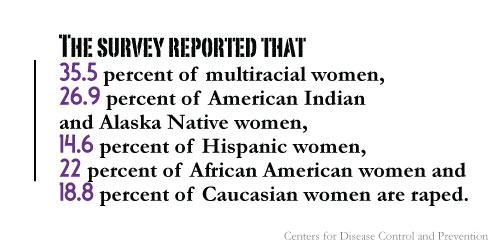
The CDC data also show one in five women and one in 71 men in the general population will experience a rape in their lifetime. Higher incidences of rape were reported among women of color: 35.5 percent of multiracial women, 26.9 percent of American Indian and Alaska Native women, 14.6 percent of Hispanic women, 22 percent of African American women and 18.8 percent of Caucasian women.
The Bureau of Justice Statistics in the U.S. Department of Justice reports that the majority of sexual assaults occur within one mile of the survivor’s home. The Bureau also finds that the average age of a perpetrator, in the case of rape, is 31 years old. Fifty-two percent of these perpetrators are white, and 22 percent are married.
According to the Bureau of Justice Statistics, 64 percent of rapes go unreported.
Back to the top
Stigmas and myths
Contrary to the belief that most rapes are perpetrated by strangers, the CDC’s fact sheet shows 51.1 percent of perpetrators are intimate partners of the survivor, 12.5 percent are family members, 40.8 percent are acquaintances and 13.8 percent are strangers.
The Minnesota Coalition Against Sexual Assault reports that the preexisting relationship between many survivors and perpetrators is a contributing factor to the low reporting rates.
The type of preexisting relationship to the perpetrator as well as the perpetrator’s social status also impacts the rate of reporting and leads to an increased sense of self-blame for the survivor, the MNCASA reports.
Survivors may be afraid to tell police, friends or family about an assault out of a fear of not being believed, feelings of shame or embarrassment or threats they may have received from the perpetrator, according to the CDC.
Back to the top
Causes
The MNCASA cites many factors as causes of the prevalence of the crime. Sexual assault is overwhelmingly committed by males, the CDC states. In its 2010 report on intimate partner violence, a majority of sexual assaults against both men and women were perpetrated by males.
While the “individual pathology” of some perpetrators causes assaults, according to the MNCASA, rape culture — a culture that condones or ignores messages of sexual violence — is also a contributing factor.
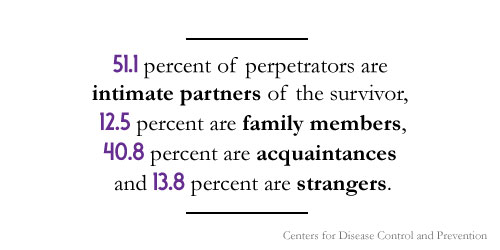
Rape culture also includes victim-blaming and rape jokes.
Susan Myers, chair of St. Thomas’ University Advocates for Women and Equity, said that victim-blaming is an attempt to absolve the perpetrator of responsibility.
“Whenever there is an act of violence, the perpetrator is the guilty party. It does not matter what the victim was doing,” Myers said. “If the victim was drinking or what the victim was wearing or whether or not the victim knew the perpetrator in advance — none of those things matter when there’s been an act of violence.”
Co-leader of FemCom Emily Kindelspire said that rape jokes can contribute to sexual violence.
“Every time students fail to understand that rape jokes are never — and never will be funny — they are creating an unsafe campus where sexual assault can prevail,” Kindelspire said.
Morgan Schreurs, co-leader of FemCom, said sexual assault often stems from an improper understanding of what consent means.
“Consent is a sober, verbal, continuous and enthusiastic yes,” Schreurs said. “So if you don’t have any of those components, whatever is happening is technically rape or sexual assault.”
Sociology professor Lisa Waldner, who has studied sexual coercion and researched both heterosexual and homosexual instances of violence, said intoxication is also a contributing factor to sexual assault. Waldner said it is normal to drink on a date, but performing a sexual act with someone who is intoxicated is assault.
Minnesota law prohibits sexual acts with a person who is “mentally incapacitated.” The MNCASA defines a person as mentally incapacitated if he or she is under the influence of drugs or alcohol given to them without their consent. A person who has willingly used drugs or alcohol is also unable to consent if he or she is “physically helpless,” meaning he or she is asleep or unconscious, too drunk to withhold consent or unable to communicate.
Back to the top
How St. Thomas handles sexual assault
Public Safety Associate Director and Manager of Investigations Michael Barrett said St. Thomas is in compliance with the Clery Act, a federal program that requires universities to report sexual violence that takes place on their campuses. He said the Clery Act also mandates that universities provide sexual assault statistics in their annual security reports.
Barrett said one sexual assault was reported in the last three annual reports. However, sexual assaults are only included in university reports if they occur on campus, on streets adjacent to campus and at school-sponsored events off-campus, according to Barrett.
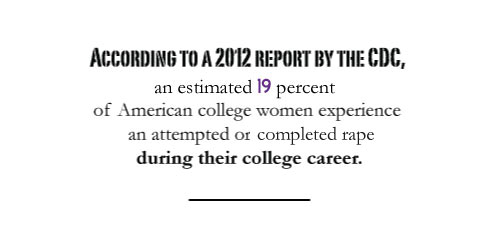
He did note that Public Safety is aware of more sexual assault allegations than are included in the annual security reports because the Clery Act does not mandate reporting assaults that take place in a student’s hometown or off-campus residence.
Barrett said that even if an assault occurs off campus, students should not hesitate to contact Public Safety or another university resource that provides help and support.
Since Barrett’s comments, another sexual assault has been reported. A non-St. Thomas-affiliated individual reported being fondled by a former St. Thomas student on campus on April 7, Public Safety’s crime logs show.
According to Public Safety, 26 reports of sexual assault were recorded in St. Thomas’ annual security reports—as mandated by the Clery Act—from 2000 to 2012.
Schreurs said many survivors do not report assaults because they do not feel safe or do not know if what happened to them was sexual assault.
“We have heard from different staff and faculty members that they’ll get students in their offices explaining a situation that happened to them, saying, ‘I’m not sure what that is or how to classify that. Was that rape? Was that sexual assault?’” Schreurs said.
Co-leader of FemCom Melissa Seymour said the limited reports of sexual assault are not necessarily positive.
“There are very few reports of sexual assault or abuse on our campus,” Seymour said. “That is really scary because it’s happening, and it’s not being reported.”
St. Thomas was the first college to use the Ramsey County Adult Sexual Assault Response Protocol, Barrett said, which has four key areas to help students: advocacy, law enforcement, medical and prosecution.
Barrett said Public Safety will assist with transportation to a hospital if needed.
The full St. Thomas sexual violence policy, currently being revised to include specific definitions for stalking, domestic and dating violence, and exploitation, can be found online here and here.
Sullivan said St. Thomas has been working to address the problem of sexual assault.
“Specific initiatives we have undertaken recently include training on bystander intervention and revisions to St. Thomas policies that address issues of sexual violence and sexual harassment,” Sullivan said. “Individuals who are found to have violated those policies are held accountable. Support for survivors is also critical, and the university strives to provide resources to survivors that help promote healing and ensure effective resolution of their concerns.”
The Dean of Students also handles sexual assaults and works closely with Public Safety when a case occurs. Interim Associate Dean of Students Rachel Harris coordinates the investigation and support processes for survivors.
“We deal with everything from what would be considered forcible fondling — so, inappropriate touching over or under clothes, touching private or sexual parts of a body. We deal with stalking. We deal with penetration,” Harris said.
The American Association of University Professors said sexual violence can be investigated two ways: the campus disciplinary process and the criminal justice system. The AAUP found most reports are handled through the universities only, not through the criminal justice system.
Back to the top
Investigative Practices
The Dean of Students office has 10 trained and certified Title IX investigators who meet with survivors and find out their needs, Harris said. The investigator and student will then talk through the student’s options.
“If you want to call the police, we’ll help you. We’ll be there when you report to the police,” Harris said.
Harris said a survivor may also have a friend or family member present if he or she wishes to.
Harris, also a Title IX investigator, said that the survivor may choose one of two options: a formal investigation or an informal process.
During the formal investigation, a Title IX investigator will take a complaint from the survivor and identify what other evidence or information is needed. The investigator will then take a statement from the perpetrator and from any witnesses who may have information.
A Title IX investigator’s goal is to get the information the dean of students needs to determine whether the perpetrator violated St. Thomas’ policy. Harris said the most serious consequences of the formal investigation are probation, suspension or expulsion of the perpetrator from the university. A university investigation does not involve law enforcement unless the survivor asks for assistance in contacting authorities.
Harris said in addition to the Title IX investigator, a survivor can work with a process coordinator who explains the investigation process.
She said that the informal process is used if students are uncomfortable with the in-depth manner of the formal investigation, or if they do not want to call the police or have the university undertake a formal investigation. A student undergoing the informal process may also work with a process coordinator.
The informal process includes options such as help making sure a survivor is not in the same class as the perpetrator, help with counseling, or assistance explaining to the perpetrator that what he or she did was wrong or that the survivor does not want to be contacted in the future.
“(Survivors might) just need some help establishing some boundaries, or they need some help saying, ‘I just want this person to know this is how it made me feel,’ and so we help accomplish that,” Harris said.
At any time during the informal process, Harris said, students may decide to switch to the formal investigation. She added that, depending on the severity of the crime, the dean of students will weigh in and decide if the case needs to be switched over to the formal investigation.
Back to the top
Prevention efforts
Various on-campus groups also work to prevent sexual assault and violence. Myers said Green Dot, a violence prevention and bystander training program, has the potential to reduce the rate of sexual violence. The program trains students on how to prevent violence in their communities.
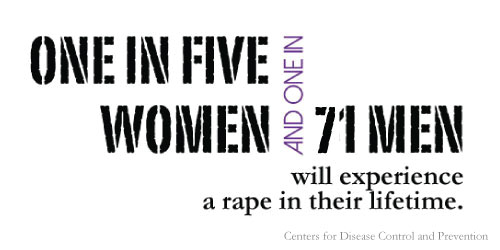
“This puts an emphasis on bystanders, on people who are around at the time to be watching out for one another, really to be acting as a community,” Myers said.
A recent article by The New York Times reported bystander intervention programs have great potential to reduce sexual assaults on college campuses. The programs teach students to intervene in any way they can, using either a direct approach or a more creative one.
Lange said St. Thomas has been teaching bystander intervention at undergraduate orientation for the last three years.
“Bystander intervention is so important,” Lange said. “Because (students are) the ones with each other at midnight or two in the morning or when you’re out and about.”
Title IX Coordinator Linda Halverson said the university also includes resident assistants and other student leaders in its sexual assault prevention strategies.
Director of Residence Life Aaron Macke said all RAs receive training every August, as well as throughout the academic year, on reporting sexual assaults on campus.
Back to the top
Support for the survivor
RAs are also trained on supporting students involved in a sexual assault, Macke said.
“Sometimes this support is when the student is in crisis and needs immediate assistance,” Macke said. “Other times, it’s just being a good listener and acting as a resource for where the student can go next.”
Halverson said that students who experience sexual assault usually first inform someone close to them of what happened.
“Those individuals are in an ideal position to encourage them to report,” Halverson said.
Schreurs said that when it comes to power-based violence such as sexual assault, it is important to give power back to the survivor.
“You never want to push them into doing anything. You never want to tell them that there’s only one right path to go,” Schreurs said. “They need to decide that for themselves.”
Support is one of the most important things for a survivor after an assault, according to the MNCASA. This means believing, respecting, accepting and listening to the victim.
Back to the top
What needs to be done
Myers said that sexual violence will have negative effects on every aspect of a victim’s life.
“Any time that there is a threat of violence or the reality of violence, obviously people are not safe,” Myers said. “Something could happen that would harm a person; it will affect how well people are able to participate in classes or just their well-being in general.”
The American Association of University Professors said many college survivors withdraw socially, miss classes, drop courses, leave school or transfer, all in an effort to avoid the perpetrator.
Myers said there’s always more to be done if a community wants to eliminate sexual violence, and dealing with a perpetrator is important.
“Having fair and equitable ways to deal with a perpetrator—so that other people are not in danger and so that perpetrator can acknowledge the harm that has been caused and make amends— that’s another thing that needs to be dealt with,” Myers said.
The AAUP urges campuses to implement education programs aimed specifically toward men, as they are the most likely perpetrators. Prevention and intervention programs can change the campus culture and show men how to prevent sexual assault.
Myers said the Wellness Center and the Luann Dummer Center for Women are spots on campus that aim to increase awareness and support survivors.
Young-ok An, director of the Luann Dummer Center for Women, said the center functions as an umbrella of support for survivors and for women in general.
“We hope to educate the campus community about various aspects of women’s issues and gender equity-related issues,” she said.
An said the empowerment of women is related to preventing violence and that the center supports broad, wide-scale events to raise awareness of violence against women on campus.
FemCom also tries to draw attention to the problem of sexual violence.
Schreurs, of FemCom, said she thinks that having posters or pamphlets around campus is a positive step.
“I think the literature on what to do if you face that situation needs to be more than just in the bathrooms because that’s really the only place you see it,” she said.
Seymour, also of FemCom, said the organization would like to see signs in every bathroom, not just the ones for women.
“Women are not the only people who face this problem,” Schreurs said.
Myers said all members of the community can work together to prevent sexual assault.
“I would like to see that we would not necessarily get to the point of having to intervene because people would recognize, would be respecting one another enough so there wouldn’t be issues of violence,” Myers said. “Obviously that’s a hope and a dream that would take a lot of work to put into a reality.”
Jamie Bernard, Rebecca Mariscal and Grace Pastoor contributed to this report.
—
TommieMedia values the voices of those with personal stories about sexual assault. Due to the sensitive and personal nature of sexual assault, TommieMedia invites readers to share their own stories and experiences through an anonymous online form. TommieMedia will consider letters signed or unsigned for posting. We will review submissions for compliance with our Terms of Service as is standard and reserve the right to edit.
Note that online commenting has been disabled for these Letters to the Editor in an effort to respect the sensitivity of the subject and victims of sexual assault.
-Heidi Enninga, Director

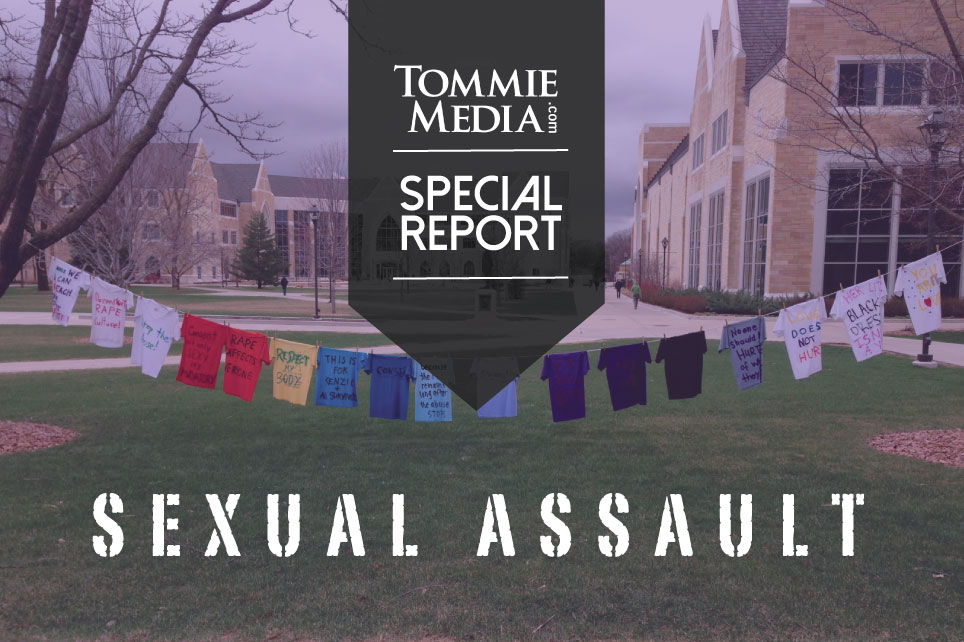
What a thorough, thoughtful look at a vastly under-reported problem. I really appreciate the multiple perspectives and explanations of why many victims fail to report assaults and how bystanders can be part of the solution.